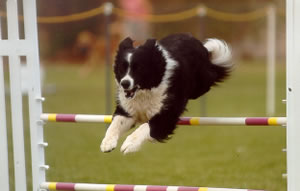 The Old Spanish Trail Arena will be the site of the second North American Dog Agility Council (NADAC) dog agility trial in Moab, on May 14-16, 2004. Dogs from all over the intermountain west (Utah, Colorado, New Mexico, Idaho and points beyond!) will be competing over timed, judged courses of jumps, ramps, tunnels and the ever-popular-with-spectators weave poles. Mixed breeds as well as purebred canine competitors are judged on their speed, accuracy and safety as they zoom around a variety of courses, ten to twenty obstacles long. The two-legged member of each team is responsible for keeping the dogs on the correct courses (most four-leggeds haven’t learned to read the numbers!), as well as ensuring safe performance of each obstacle. The Old Spanish Trail Arena will be the site of the second North American Dog Agility Council (NADAC) dog agility trial in Moab, on May 14-16, 2004. Dogs from all over the intermountain west (Utah, Colorado, New Mexico, Idaho and points beyond!) will be competing over timed, judged courses of jumps, ramps, tunnels and the ever-popular-with-spectators weave poles. Mixed breeds as well as purebred canine competitors are judged on their speed, accuracy and safety as they zoom around a variety of courses, ten to twenty obstacles long. The two-legged member of each team is responsible for keeping the dogs on the correct courses (most four-leggeds haven’t learned to read the numbers!), as well as ensuring safe performance of each obstacle.
The North American Dog Agility Council (NADAC) is one of several organizations that sponsor agility competitions. NADAC was formed in 1993, to provide North American dogs and their handlers with a fast, safe and enjoyable form of the sport of dog agility. The purpose of a NADAC agility trial is to demonstrate the ability of a dog and its handler to work as a smoothly functioning team. With separate titling divisions for Veterans and Junior Handlers and a variety of games, NADAC agility offers something for everyone! Based in northern Idaho, NADAC sponsors competitions all over North America. The Championships will be held in Castle Rock, Colorado (just south of Denver) on September 29 through October 3, 2004.
What obstacles are used?
· Jumps – Jumps can be winged, sometimes with colorful and decorative wings holding up the bars, or non-winged. Each is set at the proper height for each class, determined by the height of the dog at the withers (shoulders). Dogs must clear the full height of the jump without knocking a bar off. Handlers sometimes run into the uprights and knock bars; that’s also a fault!
· Tunnels - There are two types of tunnels, open tunnels which are long open tubes; and “chutes,” which are open at one end and have a collapsed fabric tube at the other.
· Contact Obstacles - The contact obstacles, so called because of the yellow “contact zones” at each end, include the A-frame, the dogwalk, and the see-saw. To perform these obstacles correctly, the dog must get at least one paw in each contact zone when they descend the obstacle. The contact zone rule is for safety considerations.
· Weave Poles - The dog must enter to the right of the first pole and zig-zag through to the end. They must not miss a pole.
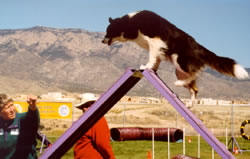 Faults occur if the handler touches the dog or an obstacle while on course; the dog runs the wrong course, misses a contact zone; misses a weave pole; displaces a jump bar; or exceeds the amount of time set by the judge for running the course. Different classes allow different numbers of faults to be considered “qualifying.” A certain number of qualifying rounds will result in a title being earned. Faults occur if the handler touches the dog or an obstacle while on course; the dog runs the wrong course, misses a contact zone; misses a weave pole; displaces a jump bar; or exceeds the amount of time set by the judge for running the course. Different classes allow different numbers of faults to be considered “qualifying.” A certain number of qualifying rounds will result in a title being earned.
Dogs are entered, depending upon their experience and previously-earned titles, at the Novice, Open or Elite level. There are special divisions for Veterans (dogs age 7 years or older, or handlers age 60 years or older) and Junior Handlers (age 17 or younger).
What events are offered?
· Regular Class requires that the dog, under the direction of the handler, perform all of the agility obstacles in the order and under the time limit set by the judge. Two courses of regular will be run on Saturday and two on Sunday.
· Gamblers Class has two distinct parts. In the first part, the handler must maneuver the dog among the obstacles in any order that he/she chooses to execute them. The dog earns points for each obstacle performed correctly. After the whistle blows, the dog must work independently away from the handler through a series of obstacles, while the handler stands behind a designated line. Two Gamblers courses will be run on Saturday.
· Jumpers Class is composed only of jumps and tunnels. Two Jumpers courses will be run on Sunday.
· Touch ‘n’ Go consists of the contact obstacles (A-frame, teeter, and dog walk) and tunnels. Two courses of Touch ‘n’ Go will be run on Saturday.
· Weavers consists of just weave poles and tunnels. Two Weavers courses will be run on Friday evening.
· Tunnelers— yep! You guessed it!—consists of just tunnels! Two of these fast and furious courses will be run on Sunday.
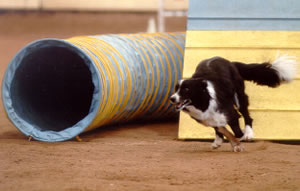 Why Do People Do This?! Why Do People Do This?!
Agility is great for dogs and people for a number of reasons.
• It can build confidence in shy or nervous dogs. Once they figure out they CAN do the obstacles, they tend to love it!
• It provides a safe and fun outlet for a dog’s energy.
• It provides a competitive environment where a dog and handler can compete not against other dogs, but just against the course and themselves.
• It builds a strong and loving bond between dog and handler. Training should always be more fun than work, and trainers should always set it up so the dog is never wrong. Dogs respond much better to positive reinforcement, and it shows in their success.
What happens at an event?
When the course has been set up, the handlers gather together for a “judge’s briefing” where the judge summarizes how the class is judged. Then the handlers may “walk the course.” They do this as a group, without their dogs, following the numbers to become familiar with how the course goes. Most handlers try to walk the course as many times as they can in the time allotted, to plan their strategy. You may see handlers during a course walk actually running the course with an imaginary dog, giving the commands as they would during their competing round. Sometimes handlers gather in little groups and discuss potential problem spots and how they are going to handle them.
The dogs run the course individually, in a pre-determined order, off leash and without collars. The timer will tell the handler when he or she may begin, starting the stopwatch as soon as the dog crosses the start line and stopping it when the dog crosses the finish. As each dog runs, the judge indicates the faults, which are noted on a sheet of paper by the scribe. At the completion of the round, the scribe records the dog’s time. The information is then conveyed to the scorekeeper, who calculates the qualifying performances and top placements. These are usually then posted somewhere for competitors to see.
Spectators are welcome; non-entered dogs are discouraged from attending.
A few rules will keep everyone happy and healthy:
· Before you reach out to pet a dog, always ask the owner/handler FIRST. Please especially be sure your children observe this rule. Please supervise your children at all times.
· Feel free to sit or stand ringside and observe, but please remember to stay back a reasonable distance from the ring itself and especially stay away from ring entrances and exits.
· It is against the rules for spectators to assist or coach the handler/dog team by, for example, yelling out the correct obstacle order from the sidelines. (Yes, handlers do sometimes get confused or lost on course!) It is also not appropriate to shout the dog’s name, since this would distract the dog from the handler’s commands.
· But please feel free to applaud and cheer the dogs on, and show your appreciation at the END of a particularly good or entertaining run.
Four Moab dogs are entered in the May trial.
Come and cheer for them and others!
* Tip, a 3-year old border collie loved and handled by Pat Byrd. Tip has been competing for nearly two years and has earned a number of titles. Though she was a bit nervous to start with, Tip has gained much confidence and really enjoys her runs!
The next three dogs are all owned and handled by Diane Allen (a true addict…).
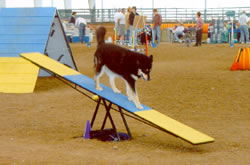 * Cisco, a German Malamutant (!) who will be 10 years old in August. He now competes in the Veterans class, jumping lower heights and having a bit more time to complete the courses. He’s never been particularly fast, and isn’t always accurate, but absolutely loves running – if it’s not too hot! * Cisco, a German Malamutant (!) who will be 10 years old in August. He now competes in the Veterans class, jumping lower heights and having a bit more time to complete the courses. He’s never been particularly fast, and isn’t always accurate, but absolutely loves running – if it’s not too hot!
* Sophie, an 8 year-old borderline collie. Sophie started agility at age three, but wants to retire now; she is entered in just a few runs once in awhile, and she too does better when it’s colder. She’s competing in the Veterans class also.
And Moab’s star,
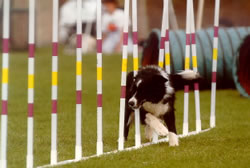 * Lucy, an 8 year-old border collie that Diane got when her previous owner died (Lucy was 3.5 years old at the time). Lucy is the epitome of a dog made for agility, and loves every minute of it (she tells everyone this as she runs!). While eligible for Veterans, she is still competing with the younger dogs, and doing great. She competed at the NADAC Championships last year in Calgary, and finished in quite respectable places in several classes. She was the first dog in Utah to complete the NATCH title (NADAC Agility Trial Champion), as well as an equivalent title for the U.S. Dog Agility Association ADCH (Agility Dog Champion) * Lucy, an 8 year-old border collie that Diane got when her previous owner died (Lucy was 3.5 years old at the time). Lucy is the epitome of a dog made for agility, and loves every minute of it (she tells everyone this as she runs!). While eligible for Veterans, she is still competing with the younger dogs, and doing great. She competed at the NADAC Championships last year in Calgary, and finished in quite respectable places in several classes. She was the first dog in Utah to complete the NATCH title (NADAC Agility Trial Champion), as well as an equivalent title for the U.S. Dog Agility Association ADCH (Agility Dog Champion)
|

 Faults occur if the handler touches the dog or an obstacle while on course; the dog runs the wrong course, misses a contact zone; misses a weave pole; displaces a jump bar; or exceeds the amount of time set by the judge for running the course. Different classes allow different numbers of faults to be considered “qualifying.” A certain number of qualifying rounds will result in a title being earned.
Faults occur if the handler touches the dog or an obstacle while on course; the dog runs the wrong course, misses a contact zone; misses a weave pole; displaces a jump bar; or exceeds the amount of time set by the judge for running the course. Different classes allow different numbers of faults to be considered “qualifying.” A certain number of qualifying rounds will result in a title being earned.  Why Do People Do This?!
Why Do People Do This?! * Cisco, a German Malamutant (!) who will be 10 years old in August. He now competes in the Veterans class, jumping lower heights and having a bit more time to complete the courses. He’s never been particularly fast, and isn’t always accurate, but absolutely loves running – if it’s not too hot!
* Cisco, a German Malamutant (!) who will be 10 years old in August. He now competes in the Veterans class, jumping lower heights and having a bit more time to complete the courses. He’s never been particularly fast, and isn’t always accurate, but absolutely loves running – if it’s not too hot! * Lucy, an 8 year-old border collie that Diane got when her previous owner died (Lucy was 3.5 years old at the time). Lucy is the epitome of a dog made for agility, and loves every minute of it (she tells everyone this as she runs!). While eligible for Veterans, she is still competing with the younger dogs, and doing great. She competed at the NADAC Championships last year in Calgary, and finished in quite respectable places in several classes. She was the first dog in Utah to complete the NATCH title (NADAC Agility Trial Champion), as well as an equivalent title for the U.S. Dog Agility Association ADCH (Agility Dog Champion)
* Lucy, an 8 year-old border collie that Diane got when her previous owner died (Lucy was 3.5 years old at the time). Lucy is the epitome of a dog made for agility, and loves every minute of it (she tells everyone this as she runs!). While eligible for Veterans, she is still competing with the younger dogs, and doing great. She competed at the NADAC Championships last year in Calgary, and finished in quite respectable places in several classes. She was the first dog in Utah to complete the NATCH title (NADAC Agility Trial Champion), as well as an equivalent title for the U.S. Dog Agility Association ADCH (Agility Dog Champion)